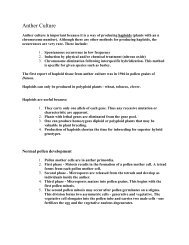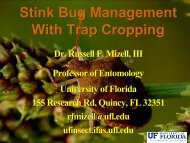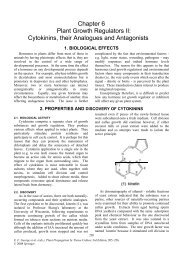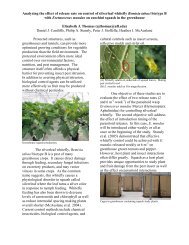The Components of Plant Tissue Culture Media II - Horticultural ...
The Components of Plant Tissue Culture Media II - Horticultural ...
The Components of Plant Tissue Culture Media II - Horticultural ...
Create successful ePaper yourself
Turn your PDF publications into a flip-book with our unique Google optimized e-Paper software.
128 <strong>The</strong> <strong>Components</strong> <strong>of</strong> <strong>Plant</strong> <strong>Tissue</strong> <strong>Culture</strong> <strong>Media</strong> <strong>II</strong><br />
the subject should be tempered with the knowledge<br />
that some or all <strong>of</strong> the sucrose in the medium is liable<br />
to be broken down into its constituent hexose sugars,<br />
and that such inversion will also occur within plant<br />
tissues, where reducing sugar levels <strong>of</strong> at least 0.5 per<br />
cent are likely to occur (Helgeson et al., 1972).<br />
3.3.1. Autoclaving.<br />
A partial hydrolysis <strong>of</strong> sucrose takes place during<br />
the autoclaving <strong>of</strong> media (Ball, 1953; Wolter and<br />
Skoog, 1966) the extent being greater when the<br />
compound is dissolved together with other medium<br />
constituents than when it is autoclaved in pure<br />
aqueous solution (Ferguson et al., 1958). In a fungal<br />
medium, not dissimilar to a plant culture medium,<br />
Bretzl<strong>of</strong>f (1954) found that sucrose inversion during<br />
autoclaving (15 min at 15 lbs/in 2 ) was dependent on<br />
pH in the following way:<br />
pH 3.0 100%<br />
pH 3.4 75%<br />
pH 3.8 40%<br />
pH 4.2 25%<br />
pH 4.7 12.5%<br />
pH 5.0 10%<br />
pH 6.0 0%<br />
<strong>The</strong>se results suggest that the proportion <strong>of</strong><br />
sucrose hydrolysed by autoclaving media at<br />
conventional pH levels (5.5-5.8) should be negligible.<br />
Most evidence suggests that this is not the case and<br />
that 10-15% sucrose can be converted into glucose<br />
and fructose. <strong>Culture</strong>s <strong>of</strong> some plants grow better in<br />
media containing autoclaved (rather than filtersterilised)<br />
sucrose (Ball, 1953; Guha and Johri, 1966;<br />
Johri and Guha, 1963; Verma and Van Huystee,<br />
1971; White, 1932) suggesting that the cells benefit<br />
from the availability <strong>of</strong> glucose and/or fructose.<br />
However, Nitsch and Nitsch (1956) noted that<br />
glucose only supported the growth <strong>of</strong> Helianthus<br />
callus if it had been autoclaved, and Romberger and<br />
Tabor (1971) that the growth <strong>of</strong> Picea shoot apices<br />
was less when the medium contained sucrose<br />
autoclaved separately in water (or sucrose autoclaved<br />
with only the organic constituents <strong>of</strong> the medium)<br />
than when all the constituents had been autoclaved<br />
together. <strong>The</strong>y suggested that a stimulatory<br />
substance might be released when sugars are<br />
autoclaved with agar.<br />
In other species there has been no difference<br />
between the growth <strong>of</strong> cultures supplied with<br />
autoclaved or filter sterilised sucrose (Mathes et al.,<br />
1973) or growth has been less on a medium<br />
containing autoclaved instead <strong>of</strong> filter sterilised<br />
sucrose (Stehsel and Caplin, 1969).<br />
3.3.2. Enzymatic breakdown.<br />
Sucrose in the medium is also inverted into<br />
monosaccharides during the in vitro culture <strong>of</strong> plant<br />
material. This occurs by the action <strong>of</strong> invertase<br />
located in the plant cell walls (Burstrom, 1957;<br />
Yoshida et al., 1973) or by the release <strong>of</strong> extracellular<br />
enzyme (King and Street, 1977). In most cultures,<br />
inversion <strong>of</strong> sucrose into glucose and fructose takes<br />
place in the medium; but, because the secretion <strong>of</strong><br />
invertase enzymes varies, the degree to which it<br />
occurs differs from one kind <strong>of</strong> plant to another.<br />
After 28 days on a medium containing either 3 or 4%<br />
sucrose, single explants <strong>of</strong> Hemerocallis and<br />
Delphinium had used 20-30% <strong>of</strong> the sugar. Of that<br />
which remained in the medium which had supported<br />
Hemerocallis, about 45% was sucrose, while only 5%<br />
was sucrose in the media in which Delphinium had<br />
been grown. In both cases the rest <strong>of</strong> the sucrose had<br />
been inverted (Lumsden et al., 1990).<br />
<strong>The</strong> sucrose-inverting capacity <strong>of</strong> tomato root<br />
cultures was greatest in media <strong>of</strong> pH 3.6-4.7.<br />
Activity sharply declined in less acid media (Weston<br />
and Street, 1968). Helgeson et al. (1972) found that<br />
omission <strong>of</strong> IAA auxin from the medium in which<br />
tobacco callus was cultured, caused there to be a<br />
marked rise in reducing sugar due to the progressive<br />
hydrolysis <strong>of</strong> sucrose, both in the medium and in the<br />
tissue. A temporary increase in reducing sugars also<br />
occurred at the end <strong>of</strong> the lag phase when newly<br />
transferred callus pieces started to grow rapidly. It is<br />
interesting to note that cell wall invertase possessed<br />
catalytic activity in situ, whether or not tobacco tissue<br />
was grown on sucrose (Obata-Sasamoto and Thorpe,<br />
1983).<br />
In cultures <strong>of</strong> some species, uptake <strong>of</strong> sugar may<br />
depend on the prior extracellular hydrolysis <strong>of</strong> sugar.<br />
This is the case in sugar cane (Komor et al., 1981);<br />
and possibly also in Dendrobium orchids (Hew et al.,<br />
1988) and carrot (Kanabus et al., 1986). Nearly all<br />
the sucrose in suspension cultures <strong>of</strong> sugar cane and<br />
sugar beet was hydrolysed in 3 days (Zamski and<br />
Wyse, 1985) and Daucus carota suspensions have<br />
been reported to hydrolyse all <strong>of</strong> the sucrose in the<br />
medium (Thorpe, 1982) into the constituent hexoses<br />
within 3 days (Kanabus et al., 1986) or within 24 h<br />
(Dijkema et al., 1990). However, most species can<br />
take up sucrose directly as was shown through studies<br />
with asymetrically labeled 14 C-sucrose (Parr and<br />
Edelman, 1975), and metabolise it intracellularly.<br />
Within the cell, soluble invertase, sucrose phosphate<br />
synthetase and sucrose synthetase serve to hydrolyse<br />
sucrose (Thorpe, 1982). Thus, in Acer (Copping and






